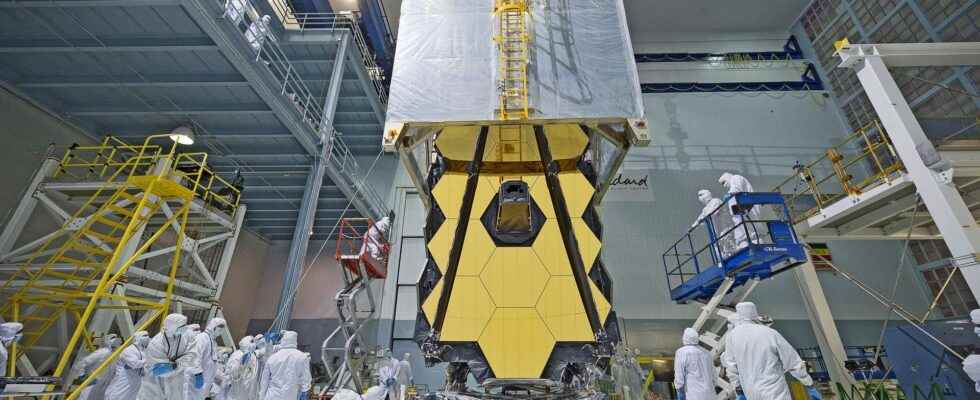A few days before the launch of the James-Webb space telescope, Futura invites you to come back to five highlights or anecdotes that punctuated the design of the new ESA and NASA device.
The launch of James-Webb Space Telescope is fast approaching, despite yet another postponement announced by theESA and NASA on December 14. The new flagship of space observation, should take off December 24th from the Kourou base in Guyana. the James Webb Space Telescope (JWST), pointed out as the successor toHubble, is also a real repository to records: colossal budget, design extended over several decades, numerous delays to its credit … A look back at five key facts which forged the reputation of one of the most ambitious projects of the last 30 years.
1. A project developed over 25 years
Twenty-five years is the duration between the first drafts of the James-Webb telescope and its launch at the end of 2021. The adventure of JWST began in 1996, under another name: the Next Generation Space Telescope (new generation space telescope). NASA decides to launch the construction a low-cost, $ 500 million space telescope. the Next Generation Space Telescope is already envisioned as the spiritual successor of Hubble, launched in 1990. Very quickly, the delays will increase, causing the slippage of the launch dates, from the 2000s to the 2010s, then finally to 2021. NASA’s postponements and the scale of the project will quickly explode the initial budget.
2. A 10 billion dollar telescope
With the James-Webb, NASA wants to create an innovative space telescope, efficient but at low cost. The administration thus caps the initial budget at $ 500 million. In 1998, two years after the first drafts of the Next Generation Space Telescope, the first delays induce an increase in the budget allocated to the project. The design of the JWST thus reached $ 1 billion. This figure will continue to increase, in parallel with technological developments and the many delays experienced by Western space agencies. In the end, the development of the JWST will have cost the staggering sum of 10 billion dollars, or 20 times its initial planned amount.
3. Go to 1.5 million kilometers
After takeoff on December 24 (subject to launch without further delay), the James-Webb telescope will travel for 29 days towards its objective: the Lagrange point L2. The latter, located 1.5 million kilometers from Earth in the direction opposite to Sun, will offer the JWST an optimal position in order to carry out its observation mission. The Lagrange point L2 is in fact an ideal region of space for deep sky observation, allowing permanent communication with the terrestrial control stations as well as a power supply thanks to the light of the Sun.
4. The James-Webb Space Telescope is also the most massive
Not surprisingly, the dimensions of the JWST are up to the scale of the project. The device thus weighs 6,500 kilograms, with a mirror primary with a diameter of 6.5 meters and a sun visor 22 by 12 meters, the size of a tennis court. For comparison, the diameter of Hubble’s primary mirror is “only” 2.4 meters in diameter. the gigantism of the James-Webb has a scientific utility, and will make it possible to collect more brightness ofstars remote and will provide a resolution more accurate celestial objects observed.
5. The JWST will see up to 100 million years after the Big Bang
the James Webb Space Telescope will have the opportunity to observe a wide range of celestial objects. While some visible bodies such as the planets of the Solar system can be imaged, the priority targets of the new space telescope are the galaxies oldest in the Universe, which appeared only 100 million years after the big Bang, over 14 billion years ago. Looking so far into the ‘past’ should allow astronomers and astrophysicists to learn more about the formation of the Universe, the first stars and galactic systems. To date, a joint observation of Hubble and Spitzer allowed us to go back to a galaxy born 400 million years after the Big Bang.
The James-Webb Telescope will launch on December 24, 2021, at 1:20 p.m. PST.
Interested in what you just read?
.
fs3
